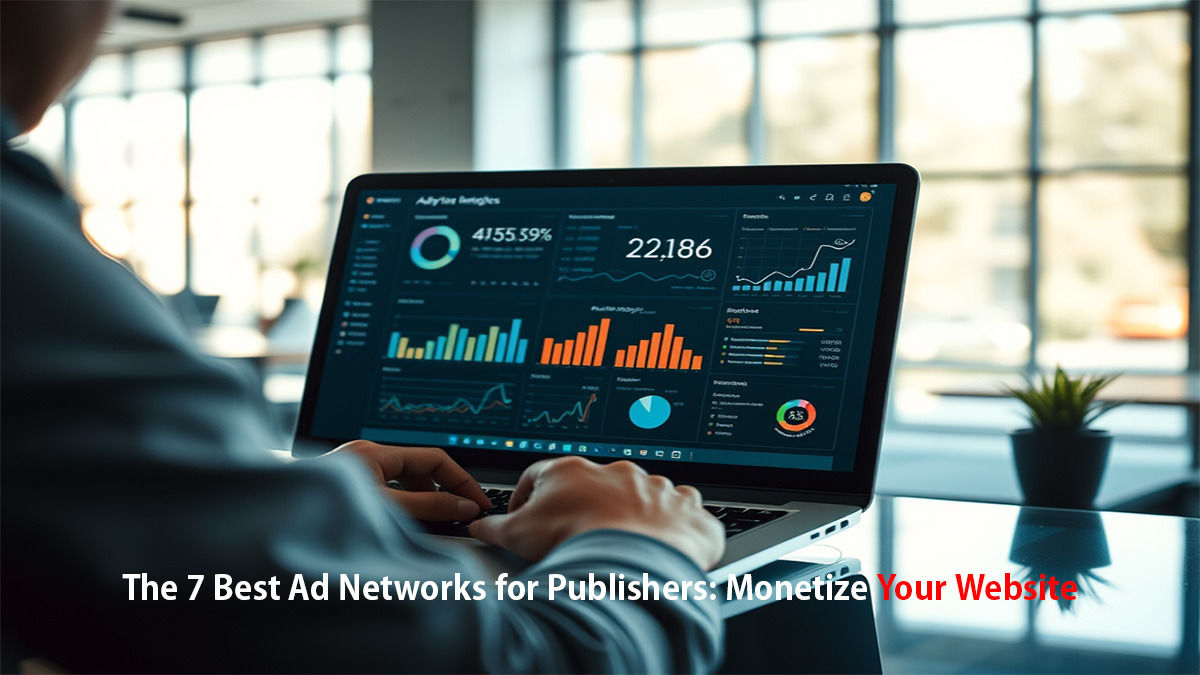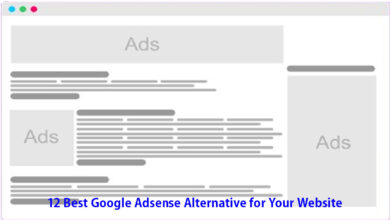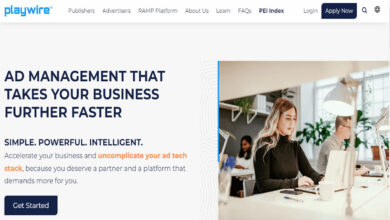The 7 Best Ad Networks for Publishers: Monetize Your Website

Advertising can be a powerful tool to monetize your website. However, it’s not just about filling your pages with random ads. To truly succeed, you need a reliable ad network that offers high-paying ads tailored to your niche.
In this guide, we’ve compiled a list of the best ad networks for publishers. Our goal is to help you make informed decisions and maximize your revenue potential.
Keeping Up-to-Date
The digital advertising landscape changes rapidly. That’s why we regularly update this article to reflect new developments in the industry and keep you informed about the best choices available.
If you notice any missing networks or have suggestions based on your experiences, please let us know! We’re committed to providing accurate and helpful information for all publishers.
How to Choose the Best Ad Network
Choosing the right ad network can make or break your online revenue. With so many options available, it’s crucial to know what to look for. Here are the top factors to consider when selecting an ad network.
1. Size Matters
The size of an ad network is vital. A larger network means more advertisers and better ad placement rates. Aim for a network with hundreds of advertisers. The more choices you have, the better your chances of finding ads that resonate with your audience.
2. Quality Over Quantity
Not all advertisers are created equal. Look for networks that prioritize quality. They should have strict vetting processes for their advertisers. This ensures you’re working with reputable brands, whether they’re big names or emerging businesses. High-quality ads enhance user experience and build trust.
3. Variety of Ad Formats
Flexibility is key in advertising. Choose a network that offers a wide range of ad formats—banners, video ads, native ads, and more. This variety allows you to experiment and find what works best for your platform and audience.
4. Transparent Payment Terms
Clear payment terms are essential for peace of mind. Look for networks that offer various payment options and straightforward conditions. Ensure there’s no risk of personal data leaks during transactions.
Conclusion
Selecting the right ad network requires careful consideration of size, quality, format variety, and payment transparency. By focusing on these factors, you can maximize your advertising potential and boost your revenue effectively!
Understanding Ad Networks: Bridging Publishers and Advertisers
In today’s digital landscape, ad networks play a crucial role. They connect app and website publishers with brands eager to promote their products. But what exactly is an ad network, and how does it work?
What Is an Ad Network?
An ad network is a platform that aggregates advertising slots from various publishers. It matches these slots with advertisers looking for space to showcase their offerings. This connection simplifies the advertising process for both parties.
Benefits for Publishers
- Easy Monetization: Instead of negotiating individual deals with multiple advertisers, publishers can rely on the ad network to fill their ad spaces. This saves time and effort.
- Access to Multiple Advertisers: Ad networks provide access to a broad range of brands, increasing the chances of filling ad slots quickly.
- Data Insights: Many networks offer analytics tools that help publishers understand which ads perform best, allowing them to optimize their strategies.
Benefits for Advertisers
- Targeted Reach: Advertisers can select specific demographics or interests, ensuring their ads reach the right audience.
- Cost-Effective Advertising: By using an ad network, brands can often secure better rates than they would through direct negotiations.
- Streamlined Campaign Management: With everything managed in one place, advertisers can easily track performance and adjust campaigns as needed.
How It Works
- Aggregation: The network collects available ad spaces from numerous publishers.
- Matching Demand: Advertisers submit their requirements—target audience, budget, etc.—and the network matches them with suitable inventory.
- Placement & Monitoring: Ads are placed in the agreed-upon slots, and both parties can monitor performance metrics through the platform.
Conclusion
Ad networks simplify the complex world of online advertising for both publishers and brands. By connecting supply with demand efficiently, they create a win-win situation that enhances revenue opportunities while delivering targeted messages to consumers.
Whether you’re a publisher looking to monetize your content or an advertiser seeking effective outreach strategies, understanding how ad networks operate is essential in today’s digital marketplace. Embrace this powerful tool and watch your advertising efforts flourish!
Why Are Ad Networks Important?
Ad networks play a crucial role in the digital advertising landscape. They simplify the process for both publishers and advertisers, creating a win-win situation.
Streamlined Connections
For publishers, ad networks eliminate the hassle of seeking out advertisers. Instead of pitching to countless brands, they can simply sign up with an ad network. This opens the door to a vast inventory of ads without the need for constant outreach.
On the flip side, advertisers benefit as well. They no longer have to spend time searching for websites to promote their products. The ad network does this heavy lifting, connecting them with suitable platforms effortlessly.
Financial Support for Publishers
Many websites rely on advertising revenue to stay afloat. By partnering with ad networks, publishers can monetize their content while keeping it free for users. This model allows them to focus on creating quality content without worrying about subscription fees or paywalls.
Access to Diverse Inventory
Ad networks provide access to a wide range of advertisements across various industries. This diversity helps ensure that publishers can display relevant ads that resonate with their audience. In turn, this leads to higher engagement rates and better returns for advertisers.
Enhanced Targeting Capabilities
Modern ad networks utilize advanced targeting technologies. Advertisers can reach specific demographics based on user behavior and preferences. This targeted approach increases the likelihood of conversions and maximizes return on investment (ROI).
Simplified Analytics
Tracking performance is essential in advertising. Ad networks offer robust analytics tools that help both publishers and advertisers measure success. With clear insights into clicks, impressions, and conversions, stakeholders can make informed decisions moving forward.
Conclusion
In summary, ad networks are vital in today’s digital ecosystem. They streamline connections between publishers and advertisers while providing financial support for content creators. By simplifying processes and enhancing targeting capabilities, these platforms foster a thriving online environment where quality content can flourish—free for users and profitable for creators alike.
Types of Advertising Networks
Advertising networks play a crucial role in connecting publishers with advertisers. They come in various forms, each catering to different needs and strategies. Here’s a breakdown of the main types of advertising networks you should know about.
1. Premium Ad Networks
Premium ad networks are all about exclusivity. They focus on delivering high-paying ads to select websites. These networks typically partner with a limited number of publishers, often requiring strict registration criteria.
Key Features:
- High Earnings: Because they offer exclusive ads, the payouts are significantly higher.
- Niche Focus: Many premium networks cater to specific niches, ensuring that ads are relevant to the audience.
- Traffic Requirements: Some may demand a minimum traffic volume, making them ideal for established sites.
If your website qualifies, joining a premium ad network can lead to lucrative earnings by serving ads that resonate with your audience.
2. Vertical Ad Networks
Vertical ad networks specialize in one niche or industry. Their primary goal is to connect businesses within that sector to their ideal target audience.
Key Features:
- Targeted Advertising: Ads are highly relevant due to precise targeting.
- Quality Over Quantity: While the volume of ads may be lower, conversion rates tend to be higher.
- Industry Expertise: Advertisers benefit from specialized knowledge about their market.
For businesses looking for focused advertising efforts, vertical ad networks can deliver impressive results.
3. Horizontal Ad Networks
Horizontal ad networks take a broader approach. They serve multiple niches and connect publishers with various advertisers across different industries.
Key Features:
- Wide Reach: These networks have extensive inventory and can fill ad slots easily.
- Less Targeting Precision: Unlike vertical networks, horizontal ones may lack precise targeting but compensate with volume.
- Diverse Options: Publishers can access a variety of advertisements from numerous sectors.
If you’re looking for flexibility and consistent fill rates for your ad spaces, horizontal ad networks might be the way to go.
4. Affiliate Ad Networks
Affiliate marketing is a performance-based strategy where publishers promote products in exchange for commissions on sales or conversions. Affiliate ad networks facilitate this process by connecting publishers with high-paying affiliate offers.
Key Features:
- Commission-Based Earnings: Publishers earn money based on performance rather than flat fees.
- Support Tools: Many affiliate networks provide reporting tools and training resources.
- Diverse Product Range: Affiliates can choose from various products that align with their audience’s interests.
For those willing to put in the effort, affiliate ad networks can be a rewarding way to monetize content effectively.
In conclusion, understanding these types of advertising networks is essential for maximizing your revenue potential as a publisher. Whether you opt for premium exclusivity or broad reach through horizontal options, there’s an advertising network suited for every strategy!
The 7 Best Ad Networks for Publishers: Monetize Your Website
In the vast world of online advertising, choosing the right ad network can feel overwhelming. With thousands of options available, how do you know which ones are truly worth your time and investment? Below, we’ll explore some of the best ad networks tailored to various niches, helping you make an informed decision.
1- Google AdSense
Google AdSense is a titan in the world of online advertising. With hundreds of thousands of publishers and advertisers, it’s a go-to choice for many. But is it the right fit for you? Let’s break down the pros and cons.
Pros of Google AdSense
- Extensive Ad Inventory
AdSense boasts a vast range of ads. This means more options for your website, allowing you to find ads that resonate with your audience. - Clean and User-Friendly Interface
Navigating through AdSense is a breeze. The platform is designed for ease, making it simple to set up and manage your ads. - Supports Various Ad Formats
Whether you prefer display ads, text ads, or video ads, AdSense has got you covered. This flexibility helps keep your site looking fresh and engaging.
Cons of Google AdSense
- Strict Content Restrictions
One downside is the stringent guidelines on what content can be monetized. If your site doesn’t align with their policies, you may face rejection. - High Minimum Payout
To cash out, you need to reach a minimum threshold of $100. For new publishers or those with low traffic, this can take time. - Not Ideal for Niche Sites
While great for generic publishers, niche websites may not see high payouts compared to alternative ad networks.
Earning Potential
AdSense operates on various models like CPC (cost-per-click), CPM (cost-per-thousand impressions), and CPE (cost-per-engagement). However, it often takes time to generate significant income—especially if you’re in a competitive niche.
Traffic Requirements
There’s no official minimum traffic requirement listed by Google. However, sites with little or no traffic may get rejected during the application process.
Payout Methods
When it comes to getting paid, AdSense offers several options: wire transfer, check, and electronic funds transfer. Choose what works best for you!
Conclusion
Google AdSense remains one of the best ad networks available today—especially for bloggers and general content creators. However, its strict content policies and high payout threshold can be hurdles for some users.
If you’re considering monetizing your website through ads, weigh these pros and cons carefully before diving in!
2- TrafficStars
TrafficStars is making waves in the advertising world. This self-serve ad platform offers a variety of features that appeal to both advertisers and publishers. Let’s dive into the pros and cons.
Pros of TrafficStars
High-Paying Ads
One of the standout features of TrafficStars is its competitive payouts. Advertisers are willing to pay top dollar for prime ad space, ensuring that publishers can earn significant revenue.
Supports Plenty of Formats
TrafficStars doesn’t limit you to just one type of ad. The platform supports multiple formats, including:
- Sliders
- Interstitials
- Video pre-rolls
- Banners
- Push notifications
This variety allows you to choose what works best for your audience.
No Minimum Traffic Requirements
Unlike many platforms, TrafficStars has no minimum traffic requirements. This means even new or smaller websites can get started without needing a massive audience.
Cons of TrafficStars
Limited Advertising Niches
While TrafficStars excels in many areas, it does have limitations when it comes to advertising niches. If your content falls outside their supported categories, you may find fewer opportunities.
Real-Time Bidding (RTB)
A unique aspect of TrafficStars is its real-time bidding feature. Advertisers can bid for ad slots as they become available. This not only maximizes outcomes for advertisers but also helps publishers gain more value from their ad spaces through competitive bidding.
Payment Models and Methods
TrafficStars offers flexible payment models including:
- CPM (Cost Per Mille)
- CPA (Cost Per Action)
- CPC (Cost Per Click)
When it comes time to cash out, you have various payout options such as bank transfer, digital currency, ePayService, Paxum, and more.
Conclusion
In summary, TrafficStars presents an attractive option for both advertisers and publishers looking for a dynamic advertising solution. With high-paying ads and diverse formats available—plus no minimum traffic requirements—it’s worth considering if you’re in the market for an effective ad platform. Just be mindful of its niche limitations when making your decision!
3- ExoClick
ExoClick stands out as one of the leading ad networks in the world. It offers publishers a robust platform to monetize their traffic effectively. Let’s dive into the pros and cons of using ExoClick.
Pros
- High Fill Rates
ExoClick boasts impressive fill rates, ensuring that your ad inventory is utilized efficiently. This means more ads are served, translating to higher revenue for publishers. - Diverse Range of Advertisers
With a broad spectrum of advertisers on board, ExoClick provides ample opportunities for publishers to find suitable ads that resonate with their audience. - Real-Time Bidding (RTB)
The RTB system allows for dynamic pricing, helping maximize revenue potential. Publishers can adjust strategies based on real-time data, optimizing earnings seamlessly. - Multiple Ad Formats
Whether it’s banners, videos, or native ads, ExoClick supports various formats. This versatility helps publishers monetize all types of inventory effectively. - Ad-Blocking Circumvention Tool
One standout feature is its tool designed to bypass ad-blocking software. This innovative solution ensures that publishers can continue earning revenue even from users who typically block ads. - Flexible Payout Options
Publishers can choose from several payout methods including wire transfer, Paxum, and BitPay—making it convenient for everyone involved.
Cons
- High Minimum Payout
One downside is the minimum payout threshold set at $50. For smaller publishers or those just starting out, this could be a hurdle before seeing any earnings. - Limited Traffic Requirements
While there’s no minimum traffic requirement, those with low traffic may find it challenging to generate significant income due to competition and lower demand for their ad space.
Conclusion
ExoClick presents an attractive option for publishers looking to monetize their websites effectively across various GEOs. With its high fill rates and diverse advertiser base, it offers valuable tools and features tailored for maximizing revenue potential.
However, keep in mind the higher payout threshold when planning your monetization strategy. Overall, if you’re ready to invest time into optimizing your ad placements and understanding your audience better, ExoClick could be a game-changer in your advertising journey!
4- Clickadu
Introduction to Clickadu
Clickadu is an ad network that stands out in the crowded digital advertising landscape. With over 3,300 registered publishers and a staggering 4 billion daily impressions, it’s a platform worth considering for monetizing your website.
Pros of Clickadu
- Multiple Payment Methods
Flexibility is key when it comes to payments. Clickadu offers various payout options, including wire transfer, WebMoney, Paxum, and PayPal. This variety ensures that publishers can choose the method that best suits their needs. - Near-Perfect Ad Fill Rate
One of Clickadu’s most impressive features is its near-perfect ad fill rate. This means that almost all available ad spaces are filled with ads, maximizing revenue potential for publishers. - Access to High-Paying Ads
Publishers can access high-paying advertisements across different formats like videos, popunders, and in-page push notifications. This diversity not only enhances user engagement but also boosts earnings significantly.
Cons of Clickadu
- High Minimum Payout
While the potential earnings are attractive, there’s a catch: Clickadu has a high minimum payout threshold. Publishers need to reach this limit before they can withdraw their earnings. - Minimum Traffic Requirement
To join Clickadu, you must have at least 5,000 visits daily. This requirement may exclude smaller websites or those just starting out from benefiting from the network.
Monetization Models
Clickadu operates on three primary monetization models:
- CPC (Cost Per Click)
- CPM (Cost Per Mille)
- CPA (Cost Per Action)
These models provide flexibility for publishers to choose how they want to earn based on their audience and traffic patterns.
Conclusion
In summary, Clickadu offers numerous advantages for seasoned publishers looking to monetize their sites effectively. With multiple payment options and a high fill rate for ads, it presents an appealing choice for those who meet its traffic requirements. However, new or smaller websites may find the barriers to entry challenging due to the high minimum traffic and payout limits.
If you’re ready to take your monetization strategy up a notch and meet the criteria, Clickadu could be your next big opportunity!
5- TrafficForce
TrafficForce is a premium advertising network designed to maximize earnings for publishers. With its robust features and flexible options, it stands out in the crowded ad marketplace. Let’s dive into the pros and cons of this platform.
Pros of TrafficForce
Real-Time Bidding
One of the standout features of TrafficForce is its real-time bidding system. This allows advertisers to compete for limited ad slots, driving up the revenue potential for publishers. As bids come in, you can watch your earnings grow.
Real-Time Reporting
Transparency is key in advertising. TrafficForce offers real-time reporting that keeps you informed about your ad performance. You can track clicks, impressions, and revenue as they happen, allowing for quick adjustments when necessary.
Customized Payout Schedules
Flexibility is crucial for any publisher. TrafficForce lets you choose your payout schedule—weekly, bi-weekly, or monthly. This customization ensures that you receive your earnings when it suits you best.
Cons of TrafficForce
High Minimum Payout
While TrafficForce offers many benefits, one downside is its high minimum payout threshold. This may be a barrier for smaller publishers or those just starting out who might struggle to reach this limit quickly.
Features at a Glance
- Ad Formats: Supports a variety of formats for both desktop and mobile.
- Advanced Targeting: Get ads tailored specifically to your audience.
- Models: Operates on CPC (Cost Per Click) and CPM (Cost Per Mille) models.
- Minimum Traffic Requirement: None required—perfect for new publishers.
- Payout Methods: Choose from cheque, wire transfer, Paxum, or PayPal.
Conclusion
TrafficForce presents an appealing option for publishers looking to boost their ad revenue through competitive bidding and comprehensive reporting tools. While the high minimum payout may deter some users, the advantages often outweigh this drawback. If you’re ready to take your advertising game to the next level, consider giving TrafficForce a try!
6- Adsterra
In the ever-evolving world of online advertising, Adsterra stands out as a top choice for publishers in 2023. With over 35,000 publishers and 15,000 advertisers on board, this ad network is gaining traction quickly. Let’s dive into why Adsterra could be your go-to platform for monetizing your website.
Quick Approval Process
One of the standout features of Adsterra is its swift website approval process. Unlike many networks that can leave you waiting for days or even weeks, Adsterra gets you up and running in no time. This means you can start earning revenue almost immediately.
Guaranteed Fill Rate
Adsterra boasts an impressive 100% fill rate. What does this mean for you? Simply put, it ensures that there will always be ads displayed on your site whenever you insert the ad code. This guarantees a steady income stream, regardless of fluctuations in traffic.
Diverse Ad Formats
Flexibility is key when it comes to ad formats. Adsterra supports various types including:
- Popunders
- Native Ads
- Banners
- In-Page Push Notifications
This variety allows you to choose what works best for your audience and maximize engagement.
High Earnings Potential
The earnings potential with Adsterra is significant. A case study highlighted a blogger who made $1,200 from around 230,000 web visits in just two months! With high rates favoring publishers, it’s clear that hard work pays off here.
No Minimum Traffic Requirement
Unlike many rival networks that impose strict traffic limits, Adsterra has no minimum traffic requirement. This opens doors for small publishers who are just starting out or those with niche audiences. You can monetize your site right away and watch your revenue grow as your traffic increases.
Bypass Ad Blockers
Ad blockers are becoming increasingly common among internet users. Fortunately, Adsterra allows you to display ads even if visitors have these blockers installed. This means more opportunities to earn money without losing potential revenue.
Flexible Payout Options
Getting paid should never be a hassle. With payout methods like PayPal, wire transfer, and Paxum available, receiving your earnings is straightforward. The minimum payout threshold is just $5—making it easy to access your funds without delay.
Exceptional Customer Support
Navigating the world of online advertising can be tricky at times. Thankfully, Adsterra offers excellent customer support. Publishers have access to dedicated account managers who are eager to help maximize revenue and resolve any issues promptly.
Conclusion
If you’re looking for an ad network that combines ease of use with strong earning potential, look no further than Adsterra. Its quick approval process, guaranteed fill rate, diverse ad formats, and flexible payout options make it an attractive choice for both new and seasoned publishers alike.
7- PropellerAds
PropellerAds is a prominent player in the world of display and mobile advertising. With over 100,000 customers, it’s clear that many advertisers and publishers trust this network. Let’s dive into the pros and cons to see if it’s the right fit for you.
Pros of PropellerAds
1. Low Payment Threshold
One of the standout features of PropellerAds is its low payment threshold. This means you can start cashing out your earnings sooner rather than later. Many networks require hefty minimums, but not here.
2. Easy Approval Process
Getting started with PropellerAds is straightforward. The approval process is quick and simple, allowing publishers to jump right into monetizing their traffic without unnecessary delays.
3. Detailed Analytics and Reporting
Data-driven decisions are key in advertising. PropellerAds provides detailed analytics and reporting tools that help you track your performance effectively. You can monitor clicks, impressions, and conversions to optimize your campaigns.
Cons of PropellerAds
1. No Real-Time Bidding
While many ad networks offer real-time bidding options, PropellerAds does not. This could limit some advertisers who prefer dynamic pricing strategies for their campaigns.
Ad Formats Offered
PropellerAds supports various ad formats including:
- Popunders
- Interstitials
- Push Notifications
This multi-format approach allows publishers to display a variety of ads, maximizing revenue potential.
Impressive Reach
With over 12 billion ad impressions delivered daily, PropellerAds has a vast reach across the globe. Advertisers can target more than 195 geographical locations (GEOs) thanks to sophisticated anti-ad fraud software that ensures quality placements.
Flexible Campaign Models
PropellerAds offers several campaign models:
- CPC (Cost Per Click)
- CPM (Cost Per Mille)
- CPA (Cost Per Action)
This flexibility allows advertisers to choose what best fits their goals and budget.
Traffic Requirements & Payout Methods
Interestingly, there are no minimum traffic requirements to join PropellerAds. This opens doors for new publishers eager to start earning from day one.
When it comes time to cash out, users have multiple payout methods at their disposal:
- PayPal
- WebMoney
- Wire Transfer
- Skrill
- ePayments
- Payoneer
Conclusion
In summary, PropellerAds stands out as a user-friendly advertising network with significant advantages like low payment thresholds and easy approval processes. While it lacks real-time bidding capabilities, its diverse ad formats and detailed analytics make it an appealing choice for both advertisers and publishers alike.
Whether you’re just starting or looking to expand your advertising strategy, consider giving PropellerAds a try!







